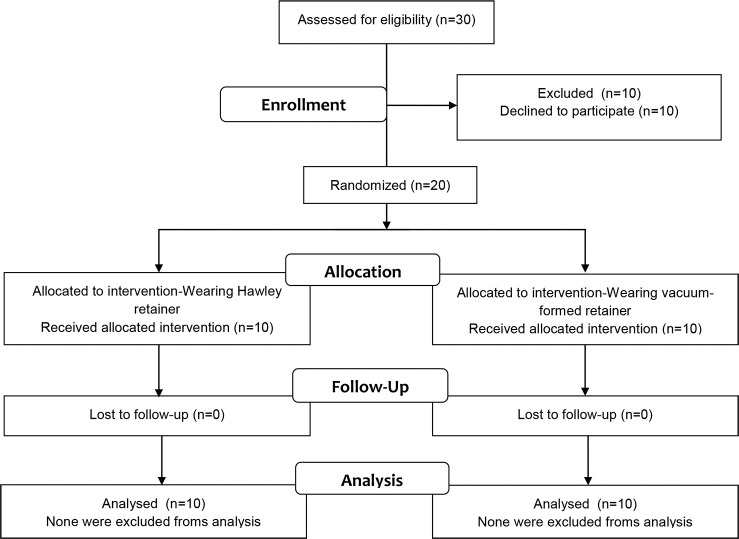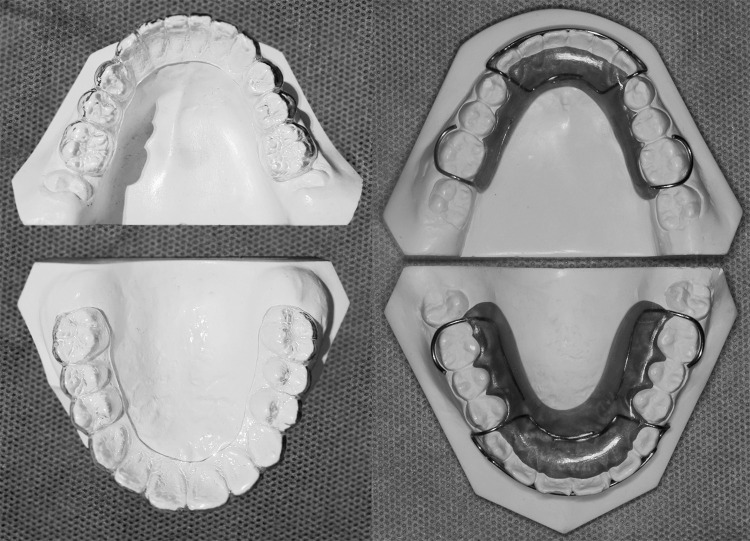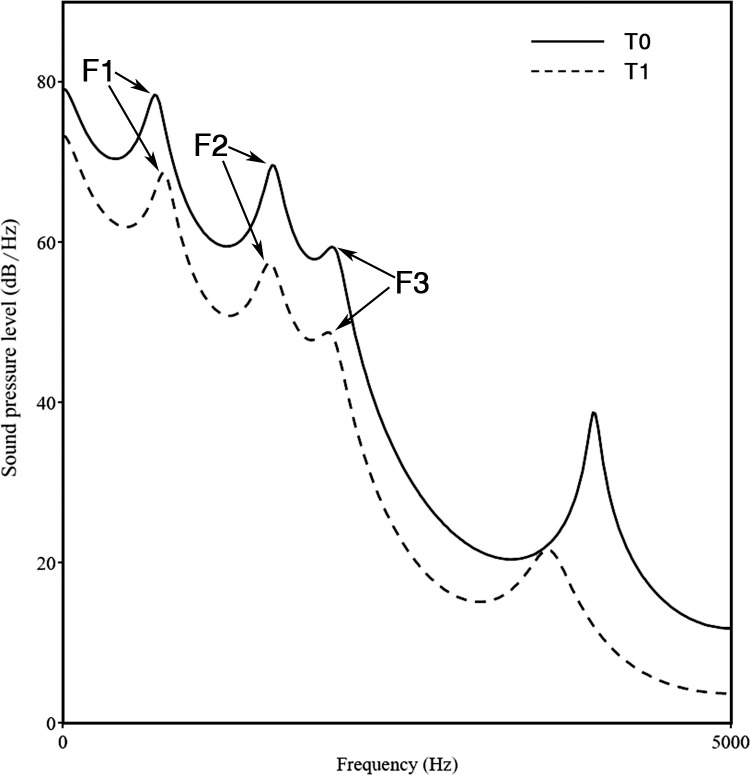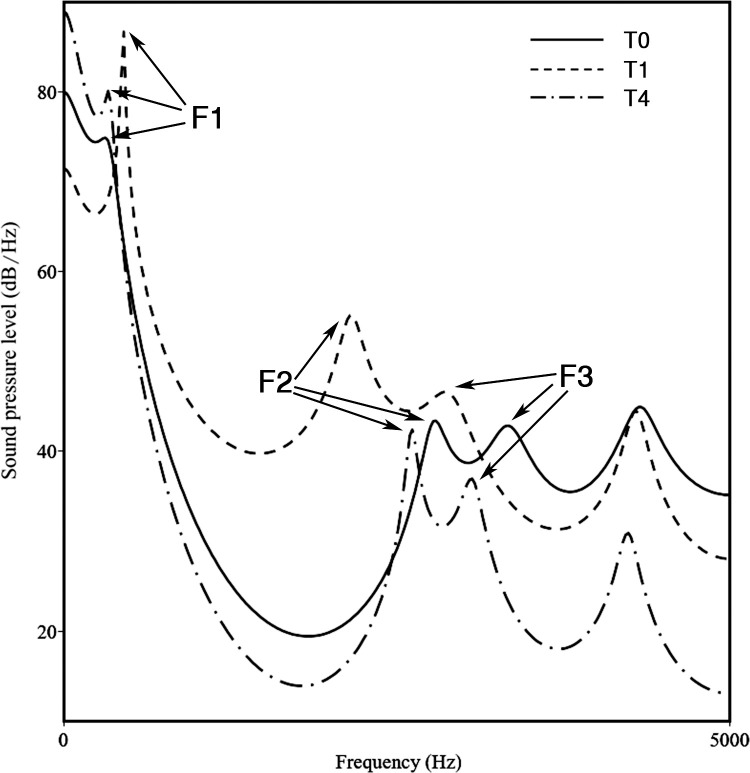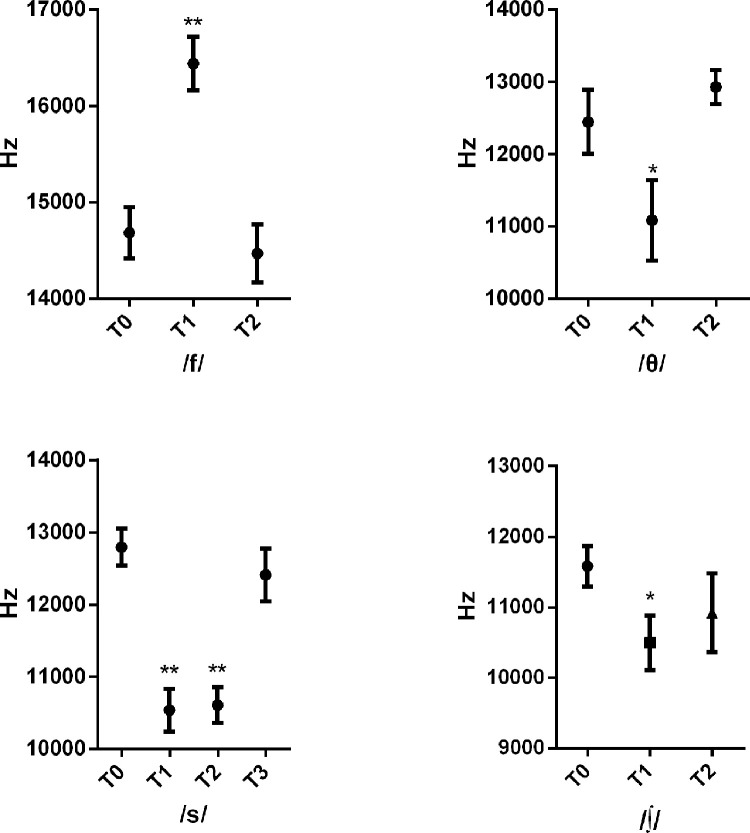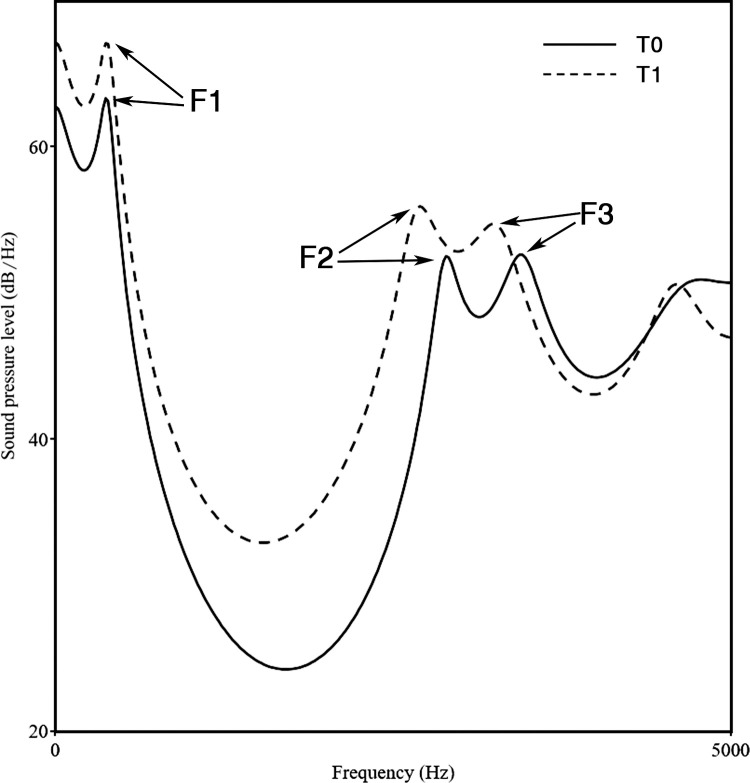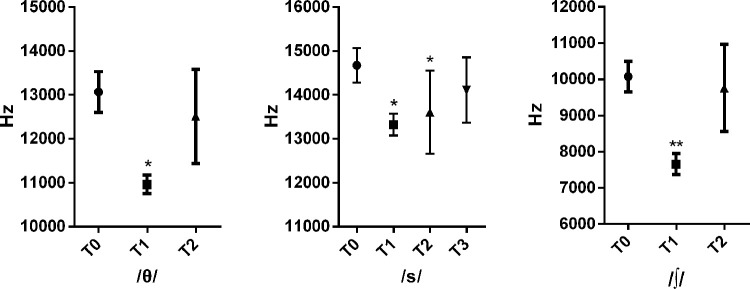Abstract
Objective:
To investigate the effects of alteration on speech articulation of adult patients between Hawley retainers and vacuum-formed retainers by an objective acoustic analysis of vowels and voiceless fricatives.
Materials and Methods:
Twenty adults, aged 19.0–29.0 years, who had just finished active orthodontic treatment were included in this study. They were divided into a Hawley retainer group and a vacuum-formed retainer group by sortation randomization method. The assessment of speech sounds was performed objectively using acoustic analysis before and after retainer application at the following time points: before wearing (T0), immediately after wearing (T1), and at 24 hours (T2), 1 week (T3), 1 month (T4), and 3 months (T5).
Results:
The production of /з:/, /i:/, /f/, /θ/, /s/, and /∫/ sounds for the Hawley retainer group and /i:/, /θ/, /s/, and /∫/ sounds for the vacuum-formed retainer group showed severe speech impairment according to acoustic analysis (P < .05). A comparison of the Hawley retainer group with the vacuum-formed retainer group revealed that the performance of /i:/, /f/, and /s/ sounds were significantly different (P < .05).
Conclusion:
Although sound distortion could be found in both the Hawley retainer group and the vacuum-formed retainer group, changes in articulation were more obvious in the Hawley retainer group.
Keywords: Hawley retainer, Vacuum-formed retainer, Speech articulation, Acoustic analysis
INTRODUCTION
After active orthodontic treatment, teeth may be in an inherently unstable position and have a tendency to return toward their initial positions due to tension in periodontal fibers. These unwanted tooth movements may lead to treatment failure without proper intervention. Therefore, orthodontic retention was introduced to maintain the teeth in their corrected positions after the completion of orthodontic movement.1
Although various types of retainers are available for orthodontic retention, including Hawley retainer (HR), vacuum-formed retainer (VFR), and lingual fixed retainer, HR and VFR are the two most commonly used types.2,3 The HR, designed by Charles Hawley in 1919, has been found effective after almost a century of clinical application. In 1971, an invisible retainer was designed as a more esthetic alternative removable type, known as a vacuum-formed retainer.4,5
There is insufficient evidence in terms of clinical effectiveness favoring either HR and VFR over the other.2,5,6 Therefore, considerations more than clinical effectiveness may be taken in regard to the choice of retainer types. For instance, speech distortion may be affected by any device that impairs the movement or appearance of soft and hard oral tissues. Therefore, changes in articulation caused by retainers should be scrutinized during retention treatment.
Only a few studies have reported the alteration of speech after orthodontic treatment. Haydar et al.7 revealed the distortion of /t/, /n/, /k/, /g/, and /p/ sounds when wearing HR for the first time. Kayikci et al.8 performed a similar study and found that /i/ and /s/ sounds underwent substantial changes after wearing HR. However, only one study indicated that VFR may exert some influence on speech articulation.9
Typical approaches to evaluate the phonetic effect exerted by lingual appliances include (1) a questionnaire, which is a common subjective method to evaluate the change on articulation of speech; and (2) subjective speech pathology examination. Khattab et al.10 compared the levels of oral impairment between fixed lingual and labial orthodontic appliances by auditive analysis. However, no one has made a comparison of the effects exerted by HR and VFR. Hence, little is known about the phonetic influence of orthodontic retention. In this study, the effects of speech distortion by HR and VFR were investigated and compared using objective acoustic analysis. Here we focused on vowels and voiceless fricatives.
MATERIALS AND METHODS
Subjects and Study Design
The study protocol was approved by the ethics committee of West China Hospital of Stomatology (ethical approval number WCHSIRB-D-2015-109). The clinical trials registration number is ChiCTR-IPR-16008572. Sample-size calculation was done performed using G*Power software Version 3.1 (Heinrich-Heine-Universitat Dusseldorf, Dusseldorf, Germany), with an alpha value of 0.05 and a power of 80%, which revealed the need for 10 subjects per group.
Thirty native Chinese who completed active orthodontic treatment were consecutively recruited between August 2015 and October 2015 (Figure 1). The exclusion criteria were as follows: (1) cleft lip or cleft palate, (2) surgical correction of the jaws, (3) dialects, (4) hearing and speech disorders, (5) temporomandibular joint dysfunction syndrome, (6) younger than 18 years, or (7) suffering from serious periodontitis. Twenty eligible, consenting individuals were randomized according to a sortation randomization method and then divided into two groups: the HR group (5 men, 5 women; 24.6 ± 2.6 years) and the VFR group (2 men, 8 women; 24.1 ± 3.1 years). Allocation concealment was achieved with opaque sealed envelopes. Operators for clinical procedures and evaluators for data collection or analysis were blinded. The HR were constructed with a 2-mm-thick U-shaped acrylic base plate, one-arm clasps with an 0.8-mm diameter stainless steel wire on the first standing molars, and a Hawley bow with 0.8-mm diameter stainless steel wire. The VFR was made of 0.8-mm-thick thermoplastic material and tightly covered all occlusal surfaces. Moreover, the VFR was trimmed to provide approximately 2-mm lingual extensions past the gingival margin (Figure 2). All devices were made in the orthodontic department laboratory, West China Hospital of Stomatology.
Figure 1.
Flow diagram of participants.
Figure 2.
Vacuum-formed retainer and Hawley retainer used in the present study.
Articulation Test and Procedure
Four long vowels and five voiceless fricatives from the International Phonetic Alphabet were tested, and four typical words for each symbol were also selected from a dictionary as a speech stimulus (Table 1). At the fitting appointment, all patients were instructed to pronounce all 36 words at their comfort levels of pitch and loudness in a quiet, soundproof room before wearing retainers (T0). Each patient was seated in an upright position, and the microphone was placed 10 cm away from his or her mouth. The speech samples were recorded using a high-quality microphone Shure SM58 (Shure Inc, Niles, Ill), which was connected to a Creative Sound Blaster Audigy 6 USB Soundboard (Creative Technology Ltd, Singapore). Recordings were transferred to the computer with 44.1 kHz sampling rate and 16 bits by Adobe Audition CS6 (Adobe Systems, San Jose, Calif), and approximately 2 seconds of additional samples were recorded before reading for the purpose of noise reduction. Recorded samples were analyzed by their acoustic characteristics using Praat Software (version 5.4.21; Amsterdam, The Netherlands).
Table 1.
Test of Articulation Used to Evaluate Distorted Sounds
| Phonetic Symbols |
Words |
|||
| Long vowels | ||||
| /α:/ | bar | car | far | pass |
| /з:/ | her | fur | first | bird |
| /i:/ | he | she | bee | see |
| /u:/ | cool | do | who | school |
| Unvoiced fricatives | ||||
| /f/ | fly | flower | five | fish |
| /θ/ | mouth | birth | three | thank |
| /s/ | face | nice | same | sister |
| /∫/ | she | shoe | show | ship |
| /h/ | head | hand | hat | hot |
Speech performances were then evaluated at the following time intervals: immediately after wearing both upper and lower retainer (T1), 24 hours later (T2), 1 week later (T3), 1 month later (T4), and 3 months later (T5). The patients were instructed during a telephone follow-up to wear the maxillary and mandibular retainers all the time throughout the 3-month period of the study, except while eating or brushing their teeth.
Acoustic Analysis
Vowels were analyzed in terms of three formant frequencies (F1, F2, and F3), and linear predictive coding analyses were used to compare the variation among each groups. Voiceless fricatives were analyzed in terms of upper boundary frequency (UBF). In these cases, voice samples were first converted to wide-band spectrogram, then fast Fourier transformation was used to locate the position of UBF.
Statistical Analysis
The data were analyzed using the SPSS 21.0 (SPSS Inc, Chicago, Ill) statistics package. In each case, the level of significance was set at .05. Paired-sample t-tests were adopted to evaluate personal changes of each symbol. For vowels, a significance of distortion was defined when any of three formants frequency showed significant difference. Repeated-measures analysis of variance was employed to evaluate changes between T0 and other time points, as well as changes between the HR group and the VFR group.
RESULTS
Articulation Test
Table 2 shows the number of distortions between T0 (articulation test before the initiation of retainer wear) and other time points. For the HR group, six of the nine phonetic symbols demonstrated significant changes after wearing both upper and lower retainers at the first time (T1). After a week of adaptation (T3), most of the symbols could be pronounced correctly, except for /i:/ and /s/ sounds. Two patients presented speech distortions of the /i:/ sound, and three patients presented speech distortion of the /s/ sounds after 1 month (T4), Only one patient in the HR group showed speech distortions of the /s/ sound after 3 month (T5), whereas for the VFR group /i:/, /θ/, /s/, and /∫/ sounds presented significant distortion after wearing both upper and lower retainers initially, which lasted for 24 hours to 1 week. None of the subjects in this group had any speech distortions after an interval of 1 month. A comparison of the HR group with the VFR group at the same time point revealed significant differences at T1 and T2 for /i:/, /f/, and /s/ sounds compared with T0 (P < .05).
Table 2.
Comparison of the Number of Sound Distortions at Different Observation Periods
| Phonetic Symbols |
Hawley Retainer (n) |
Vacuum-Formed Retainer (n) |
||||||||
| T1 |
T2 |
T3 |
T4 |
T5 |
T1 |
T2 |
T3 |
T4 |
T5 |
|
| /α:/ | 4 | 1 | 0 | 0 | 0 | 4 | 2 | 0 | 0 | 0 |
| /з:/ | 6** | 4* | 0 | 0 | 0 | 4 | 1 | 1 | 0 | 0 |
| /i:/ | 8**a | 5** | 4** | 2** | 0 | 6** | 5* | 0 | 0 | 0 |
| /u:/ | 1 | 1 | 0 | 0 | 0 | 4 | 2 | 0 | 0 | 0 |
| /f/ | 6**a | 2**a | 0 | 0 | 0 | 3 | 1 | 1 | 0 | 0 |
| /θ/ | 5** | 2* | 1 | 0 | 0 | 5** | 1** | 0 | 0 | 0 |
| /s/ | 9**a | 7**a | 4** | 3** | 1 | 9** | 5** | 0* | 0 | 0 |
| /∫/ | 3** | 1* | 1 | 0 | 0 | 4** | 0 | 0 | 0 | 0 |
| /h/ | 0 | 0 | 0 | 0 | 0 | 1 | 0 | 0 | 0 | 0 |
P < .05 compared with T0 by repeated-measures ANOVA.
P < .01 compared with T0 by repeated-measures ANOVA.
P < .05 compared between the Hawley retainer group and the vacuum-formed retainer group by repeated-measures ANOVA.
T0 indicates before wearing retainers; T1, immediately after wearing both upper and lower retainer; T2, 24 hours later; T3, 1 week later; T4, 1 month later; T5, 3 months later; ANOVA, analysis of variance.
Acoustic Analysis for HR group
For the HR group, long vowels were described in three formants. For a typical formant frequency change of the /з:/ sound, the F1 frequency was recorded as 682.54 Hz without a retainer and increased to 762.90 Hz (P < .05) when both retainers were worn, whereas F2 and F3 showed a small change between T0 versus T1 (P > .05; Figure 3). For the /i:/ sound, the F1 frequency increased with F2 and F3 dropped after initial wearing, all of which showed significant differences (P < .01). After 1 month of adaptation, the F1 and F2 frequencies returned to normal, whereas for some patients the F3 frequency still had a significant decrease compared with T0 (P < .05; Figure 4).
Figure 3.
Typical formant frequency change of the /з:/ sound in the Hawley retainer group.
Figure 4.
Typical formant frequency change of the /i:/ sound in the Hawley retainer group.
Four of the five voiceless fricatives were found to have distortions that were statistically significant difference for the HR group. The upper boundary frequency of the /f/ sound showed a substantial increase at T1 (P < .01) but was back to normal at T2 (P > .05). For the /θ/ sound, the UBF decreased at T1 (P < .05) but was back to normal at T2 (P > .05). The /s/ sound was the most distorted sound in the HR group, and the mean UBF decreased from 12793.00 Hz at T0 to 10537.75 Hz at T1 (P < .01), remained at lower frequency of 10607.5 Hz at T2 (P < .01), then was back to 12409.25 Hz at T3 (P > .05). For the /∫/ sound, the UBF showed a significant decrease at T1 (P < . 05) but back to normal at T2 (P > .05, Figure 5).
Figure 5.
UBF changes of the /f/, /θ/, /s/, and /∫/ sounds from typical patients in the Hawley retainer group. * P < .05; ** P < .01.
Acoustic Analysis for VFR group
For the VFR group, only the /i:/ sound demonstrated speech distortion among long vowels compared with the HR group. As is shown in Figure 6, only the F2 and F3 frequencies had a significant decrease at T1 (P < .05), and all changes returned to normal in 1 week. For voiceless fricatives, /θ/, /s/, and /∫/ showed the most distortion. The UBF of the /θ/ sound showed a significant decrease at T1 (P < .05) but was back to normal at T2 (P > .05). For the /s/ sound, the mean UBF decreased from 14672.50 Hz at T0 to 13327.00 Hz at T1 (P < .05), remained at the lower frequency of 13608.50 Hz at T2 (P < .05), then was back to normal at T3 (P > .05). For the /∫/ sound, the UBF showed a significant decrease at T1 (P < .01) but was back to normal at T2 (P > .05; Figure 7).
Figure 6.
Typical formant frequency change of the /i:/ sound in the vacuum-formed retainer group.
Figure 7.
UBF changes of the /θ/, /s/, and /∫/ sounds from typical patients in the vacuum-formed retainer group. * P < .05; ** P < .01.
DISCUSSION
Formants Analysis
Formants were usually used for the evaluation of vowels. Phoneticians focus on the first three formants for linguistic information. The first formant frequency (F1) correlates to the articulatory height of the vowel and rises when the tongue is lowered. The second formant frequency (F2) reflects roughly the backness of the vowel and rises when the tongue moves toward the front. The closer they are together, the more “back” a vowel sounds. The third formant frequency (F3) adds to quality distinctions, which is more dependent on the area of lip cavity and could rise when accompanied by the decrease of the lip cavity.11,12
Among four long vowels, the /i:/ and /з:/ sounds demonstrated significant differences when wearing HR. The /i:/ sound is a high front vowel, and during pronunciation while wearing the HR, the primary position of the tongue reached maxillary U-shaped acrylic base plate, which in turn moved to a lower position, resulting in the increase of F1 frequency. Additionally, when the tongue contacted the lower acrylic base plate covering alveolar ridge/palatal, features such as lip roundness and protrusion changed, the tongue position retruded to a back position, and the decrease of F2 frequency was rendered. In addition, the lip could be pushed to an outer position by protruding stainless steel wire from the labial tooth, enlarging the labial space and resulting in F3 frequency decreases.8,12 For most patients in the HR group, changes of F1 and F2 frequencies may return to normal after a week, but F3 frequency distortion could last for more than a month. This phenomenon is in accordance with the discomfort of the protruding stainless steel wire, which may last for a long time. For the /з:/ sound, the tongue may be situated in a higher position, and this position resulted in the contact of the tongue with the acrylic base plate of the maxillary retainer, which in turn moved to a lower position followed by the increased F1 frequency.
The /i:/ sound in the VFR group also represented an obvious distortion after first-time wearing. However, unlike the HR group, the frequency of F1 in the VFR group showed a smaller change, which indicates that the thermoplastic material did not cover most of palate space and the thickness of VFR was thinner than that of HR. However, because the thermoplastic material covered the upper teeth, the tongue retruded to a posterior position, leading to a decrease in the F2 frequency. The reason for the decrease of the F3 frequency in the VFR group was similar to that in HR group; as the protrusion of thermoplastic material was less obvious than the stainless steel wire, patients could easily adapt and the duration of speech distortion was shorter.
Analysis for Voiceless Fricatives
The UBF is usually used to describe the vocal characteristic of voiceless fricatives. The /s/ sound showed the most obvious distortion in both groups. Normally, when the /s/ sound is pronounced, the lateral margins of the tongue contact the palatal alveolar process of the posterior maxillae, allowing a stream of air to pass through this medial groove and the space between central incisors. A larger space for the air outflow tract or the overcontouring of the anterior palatal area may result in a decrease of the UBF.10,13,14
For the HR group, the decrease of the UBF for the /s/ sound could be explained in two ways. First, the area of air outflow tract was enlarged. The middle palate was empty when the lateral margins of the tongue contacted the U-shaped acrylic base plate of maxillary retainer. Second, overcontouring of the anterior palatal area was caused by the frontier acrylic base plate. For the VFR group, the decrease of UBF for the /s/ sound could also be caused by two factors: one was less contouring of the anterior palatal area of the thermoplastic material, and the other was the increased vertical dimension between upper and lower teeth because the thermoplastic plate covered all occlusal surfaces. Patients in this VFR group could easily adapt, and speech impairment of the /s/ sound lasted for a shorter time.
The /θ/ sound is pronounced when the tip of the tongue is close to the upper front teeth. The frontier acrylic base plate of upper HR and the thermoplastic material of upper VFR may influence the contact between tongue and upper front teeth, thus affecting the UBF of /θ/ sound. For the pronunciation of the /f/ sound, the incisal edges of the upper teeth contacts the wet-dry line of the lower lip, and the tongue exerts less influence on the /θ/ sound. The speech impairment for this sound was more common in HR group, because the lower lip was pushed to an outer position by the protruded stainless steel wire on labial tooth, which changed the normal contact between upper teeth and lower lip. For the /∫/ sound, the lateral acrylic base plate of the upper HR and thermoplastic material of upper VFR may influence the contact between the tongue and upper side teeth, thus affecting the UBF.
Other Influencing Factors in This Experiment
A previous study showed that pitch and formant frequencies may change significantly during puberty, whereas this change ends at the age of 18 years.15 To ensure that the sound pronouncing methods for each patient at different examination times were approximately the same, the age criterion (older than 18 years) was selected in our study to avoid sound mutation from puberty. In addition, all patients had the experience of learning English for more than 10 years. English pronunciation experts were also used to guarantee the accurate pronunciation of those designed words before recruitment. Thus, in our trial, we assumed that all subjects could pronounce their designated words accurately.
To reduce the influence of impairment in speech as much as possible, two measures should be taken. The first is to encourage retainer-wearing patients to practice distortion sounds, and the second is to change the structure of the retainer so that it will be less likely to influence speech. Stronger materials may be used to reduce the retainer thickness. In addition, grooving and roughening the anterior alveolar areas of retainer can help the tongue to find a suitable position in the oral cavity.9,16
CONCLUSIONS
The results of this study demonstrated that sounds such as /з:/, /i:/, /f/, /θ/, /s/, and /∫/ for the HR group and /i:/, /θ/, /s/, and /∫/ for VFR group showed severe impairments in speech by acoustic analysis.
A comparison of the HR group with the VFR group revealed that the /i:/, /f/, and /s/ sounds showed significant differences; changes in articulation were more obvious in the Hawley retainer group.
Therefore, we concluded that patients should be informed of the influence on speech caused by orthodontic retainers before their placement and should be encouraged to adapt to these changes.
ACKNOWLEDGMENTS
This study was supported by grants from the Science and Technology Department of Sichuan Province (No. 2015SZ0078). We would also like to express our sincere thanks to Pat Keating, chair of the International Phonetic Association, professor in the Department of Linguistics at UCLA (Los Angeles, Calif), for her insightful comments and critical reading of the manuscript. We also extend our thanks to Professor Kang DY for all his help with statistical analysis.
REFERENCES
- 1.Johnston CD, Littlewood SJ. Retention in orthodontics. Br Dent J. 2015;218:119–122. doi: 10.1038/sj.bdj.2015.47. [DOI] [PubMed] [Google Scholar]
- 2.Mai W, Meng H, Jiang Y, et al. Comparison of vacuum-formed and Hawley retainers: a systematic review. Am J Orthod Dentofacial Orthop. 2014;145:720–727. doi: 10.1016/j.ajodo.2014.01.019. [DOI] [PubMed] [Google Scholar]
- 3.Rowland H, Hichens L, Williams A, et al. The effectiveness of Hawley and vacuum-formed retainers: a single-center randomized controlled trial. Am J Orthod Dentofacial Orthop. 2007;132:730–737. doi: 10.1016/j.ajodo.2006.06.019. [DOI] [PubMed] [Google Scholar]
- 4.Sun J, Yu YC, Liu MY, et al. Survival time comparison between Hawley and clear overlay retainers: a randomized trial. J Dent Res. 2011;90:197–1201. doi: 10.1177/0022034511415274. [DOI] [PubMed] [Google Scholar]
- 5.Demir A, Babacan H, Nalcacı R, Topcuoglu T. Comparison of retention characteristics of Essix and Hawley retainers. Korean J Orthod. 2012;42:255–262. doi: 10.4041/kjod.2012.42.5.255. [DOI] [PMC free article] [PubMed] [Google Scholar]
- 6.Barlin S, Smith R, Reed R, Sandy J, Ireland AJ. A retrospective randomized double-blind comparison study of the effectiveness of Hawley vs vacuum-formed retainers. Angle Orthod. 2011;81:404–409. doi: 10.2319/072610-437.1. [DOI] [PMC free article] [PubMed] [Google Scholar]
- 7.Haydar B, Karabulut G, Özkan S, Aksoy AÜ, Ciğer S. Effects of retainers on the articulation of speech. Am J Orthod Dentofacial Orthop. 1996;110:535–540. doi: 10.1016/s0889-5406(96)70062-8. [DOI] [PubMed] [Google Scholar]
- 8.Kayikci ME, Akan S, Ciger S, Ozkan S. Effects of Hawley retainers on consonants and formant frequencies of vowels. Angle Orthod. 2012;82:14–21. doi: 10.2319/032911-226.1. [DOI] [PMC free article] [PubMed] [Google Scholar]
- 9.Hohoff A, Stamm T, Goder G, et al. Comparison of 3 bonded lingual appliances by auditive analysis and subjective assessment. Am J Orthod Dentofacial Orthop. 2003;124:737–745. doi: 10.1016/j.ajodo.2003.08.022. [DOI] [PubMed] [Google Scholar]
- 10.Khattab TZ, Farah H, Al-Sabbagh R, Hajeer M, Haj-Hamed Y. Speech performance and oral impairments with lingual and labial orthodontic appliances in the first stage of fixed treatment: a randomized controlled trial. Angle Orthod. 2013;83:519–526. doi: 10.2319/073112-619.1. [DOI] [PMC free article] [PubMed] [Google Scholar]
- 11.Bowers J, Tobey EA, Shaye R. An acoustic-speech study of patients who received orthognathic surgery. Am J Orthod. 1985;88:373–379. doi: 10.1016/0002-9416(85)90064-8. [DOI] [PubMed] [Google Scholar]
- 12.Fant G. The relations between area functions and the acoustic signal. Phonetica. 1980;37:55–86. doi: 10.1159/000259983. [DOI] [PubMed] [Google Scholar]
- 13.Kong HJ, Hansen CA. Customizing palatal contours of a denture to improve speech intelligibility. J Prosthet Dent. 2008. 99 243–248. [DOI] [PubMed]
- 14.Roumanas ED. The social solution—denture esthetics, phonetics, and function. J Prosthodont. 2009;18:112–115. doi: 10.1111/j.1532-849X.2009.00440.x. [DOI] [PubMed] [Google Scholar]
- 15.Hodges-Simeon CR, Gurven M, Cárdenas RA, Gaulin SJ. Voice change as a new measure of male pubertal timing: a study among Bolivian adolescents. Ann Hum Biol. 2013;40:209–219. doi: 10.3109/03014460.2012.759622. [DOI] [PubMed] [Google Scholar]
- 16.Erb DP. Speech effects of the maxillary retainer. Angle Orthod. 1967;37:298–303. doi: 10.1043/0003-3219(1967)037<0298:SEOTMR>2.0.CO;2. [DOI] [PubMed] [Google Scholar]



